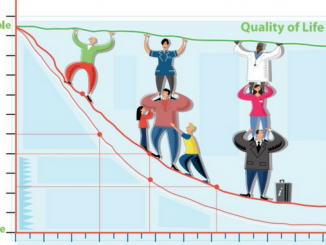
Patients are still dying in agony despite concerned efforts over many years to change attitudes towards the use and control of opiates. Could a new initiative, which works with NGOs, governments and policy makers to address practical problems, finally hit the spot?
When his cancer pain grew so great he could see no other means of escape, former police officer Bernard Ng from Singapore considered killing himself. But that changed when a hospice provided him with effective pain relief.
“I once gave up living,” he says, fighting back the emotion during an interview for the feature film ‘Life Before Death’, released worldwide this February. “I once told my wife, and myself, ‘I don’t have quality of life – what is the use of living?’ But today I see it the other way. I want to go on living. With medication and the doctor’s help I’m okay.”
“I’m not asking for a lot. I just want to live a normal life without pain. And if possible I can do all the basic things like take a bath, change my own clothes, you know, without bothering my wife.”
According to the Union for International Cancer Control (UICC), more than 3.3 million people with cancer are dying in pain, sometimes in agony, each year. Altogether, tens of millions of people are needlessly suffering pain, and a WHO estimate says that 600 million are going to suffer from untreated pain in their lifetime. The reason is simple: lack of access to basic, cheap and highly effective drugs, notably morphine. Around 70% of cancer deaths occur in low and middle-income countries, where just 6% of the opioid analgesics are consumed.
Around 70% of cancer deaths are in poorer countries, where just 6% of the opioid analgesics are consumed
Behind that bald fact lies a complex tale of global over-regulation, corporate indifference, burdensome red tape, professional fear and pervasive misunderstanding. Drugs aren’t getting to people, not because they are expensive or hard to administer but because systems are failing.
Now an initiative from the Union for International Cancer Control (UICC) and the American Cancer Society (ACS) aims to end this needless suffering. The Global Access to Pain Relief Initiative (GAPRI), launched in 2010, is spearheading a range of actions to make effective pain relief a global reality by 2020. It aims to improve the market for pain medicines, empower governments to expand pain relief, strengthen health systems and mainstream the issue of pain treatment in the global health agenda.
The invisible problem
According to Meg O’Brien, GAPRI director, untreated pain has long been the invisible world health problem, always falling between the cracks of other initiatives. It is common even in countries like the US and UK, but the problem is most dramatic in sub-Saharan Africa, which has 20% of painful deaths in the world, and just 1% of the morphine.
GAPRI has identified the main barriers to people accessing pain relief as legal and regulatory restrictions, weak health systems, and concerns about drug diversion and addiction. All of these interact. But Meg O’Brien says that if she could wave a wand to change one thing, it would be to fix clinicians’ attitudes to morphine.
“There are so many myths and misunderstandings about the drugs,” she says. “The reality is that, in many countries, even if we were to fix regulations that restrict access to the drugs, we’d see the drugs expire on the shelves because they were under-used.”
“The reason is partly historical. When, in the past, pain relief was not easily available and physicians had nothing to give patients, they had to provide a story to explain it. That story was that drugs like morphine are dangerous and addictive. And that story has continued to this day. Some clinicians find it easier to build a wall between themselves and the patient, saying they can’t do anything for the pain. They breed an acceptance that HIV hurts, or cancer hurts.”
This is the experience in Zimbabwe, where fear and ignorance about morphine conspire with highly restrictive drug control legislation to make good pain control a rarity. According to Dickson Chifamba, executive director at the Island Hospice Service, only 30% of people who need pain relief get it in Zimbabwe. “A doctor has to report to the Secretary of Health any patient who has been on morphine for more than four months,” he says. “So because of the bureaucracy a number of doctors do not want be bothered with prescribing morphine.” Resistance is particularly great from older doctors, who have not been trained in palliative care.
“Because of the bureaucracy a number of doctors do not want be bothered with prescribing morphine”
“There are also the usual fears of addiction and respiratory depression, which means that both doctors and patients see morphine as a medicine of very last resort. They hold off until the patient is in agonising pain.” Chifamba recalls recently visiting a cancer patient who was screaming in agony. He was alarmed because on his last visit the patient’s pain had been well controlled. When he asked the relatives what had happened, they said they had not collected the morphine doses because they believed it was slowly killing the patient. Many families, he says, believe that morphine should not be given continuously – only when pain is extreme.
Supply-side issues
There are supply problems with morphine too. Chifamba points out that UN conventions designed to control the illegal use of drugs have ingrained highly restrictive systems. Supply problems are exacerbated by the fact that the big players in the pharmaceutical industry show little interest in producing morphine because profits come from patented medicines. That leaves it to small companies, with more limited capacity, to supply middle- and lower-income countries.
David Lee, an expert on opiates and senior strategic advisor for Endo Pharmaceuticals, acknowledges that if there were more profit in morphine the global dynamics of supply and demand would be very different. “It’s certainly a low margin business for the pharmaceutical industry. But I don’t think you can say the whole situation is their fault.”
If there were more profit in morphine the global dynamics of supply and demand would be different
“In rich countries, there are many types of opiates, but for many low- to middle-income countries morphine is the only option for severe pain,” says Lee, who is CEO of the LAMB Pain Foundation and leads a project managed by the Foundation for Hospices in Sub-Saharan Africa and the African Palliative Care Association to educate hospital administrators and healthcare workers in good pain management and treatment. “It’s cheap in principle, and the process to convert the raw material is relatively easy. But movement of it is heavily controlled by international and national laws.”
Influential governments waging wars on illegal drugs are putting political pressure on governments around the world not to loosen laws controlling distribution. “There is a lot of emphasis on control, and less on controlled availability,” says Lee.
On top of this, national or local legal frameworks to get morphine where it is needed are either non-existent or so cumbersome that health professionals are not prepared to take them on. “There’s a reluctance to prescribe because of fear of legal sanction,” says Lee.
A new determination
But if the global obstructions to good pain management are intricate and deep-rooted, there are at least now signs of a growing international determination to overcome them.
First and foremost was the establishment of GAPRI itself – the brainchild of David Hill, UICC President (2008–2010), who pushed the idea ahead in the light of increasing concerns about pain control in the international cancer community. GAPRI has taken shape alongside another project which has helped give voice, images and publicity to its campaign – a feature film called ‘Life Before Death’ about the global crisis in pain, produced and directed by David Hill’s son, Mike. The award-winning documentary, filmed in 11 countries and released this year, interviews health professionals battling the pain epidemic and patients who have experienced extreme pain, and argues for effective pain treatment as a basic human right (www.lifebeforedeath.com).
Both initiatives have taken place in the context of new expressions of a global will to address palliative care issues. Last year’s UN General Assembly political declaration on non-communicable disease stated that national policies should improve access to palliative care and foster partnerships between government and civil society to support palliative care services.
The World Cancer Declaration, drawn up by UICC in 2008, is more specific. One of its targets for 2020 is that effective pain control measures will be available universally to all cancer patients in pain. The declaration calls for action where over-regulation hinders good pain control, and stipulates that governments and international organisations should not allow global implementation of the UN’s international drug control conventions to interfere with legitimate efforts to advance access to pain medicines.
A hard-hitting report from the Global Task Force on Expanded Access to Cancer Care and Control in Developing Countries has highlighted the fact that “pain control, an issue for all cancers and many other diseases, offers the most distressing and insidious example of the cancer divide.”
From words to outcomes
David Lee welcomes the new political will to act. But what will turn words into actions, and actions into outcomes?
“All this high-level, professional noise is helpful because there’s a reference point, an anchor,” he says. “It now needs people who have the ability to do something, to do something. There are a lot of well-intentioned people wanting to change things, but one of the frustrations of the not-for-profit sector is that sometimes people work against each other, rather than working together. There are signs now that it’s beginning to happen. I think that the GAPRI initiative is particularly important in this respect, because of the way it interacts with so many different NGOs, governments and other bodies.”
“It now needs people who have the ability to do something, to do something”
Meg O’Brien too believes that GAPRI is getting things moving. “It’s a bit like a leaky pipe – you have to fix all the holes at the same time, or else the water starts coming out somewhere else,” she says. Issues of availability and training of health professionals in pain control have to be addressed simultaneously. GAPRI is doing this by developing good-practice models that will prove what can be done and will spread knowhow.
The pain-free hospital initiative, for example, is a one-year programme to change clinical practices at key hospitals worldwide during 2012. It provides training for physicians and nurses to evaluate and treat pain, using targeted advocacy campaigns within the hospital to increase awareness of treatable pain. Simultaneously, it works with government officials to ensure that essential pain medicines are available at all times. GAPRI has launched the project in three hospitals in India, and is working to find funding for similar projects in Vietnam, Haiti, Tanzania, Ethiopia, Turkey and Egypt.
“We make films with patient stories, have teeshirts for patients to wear, and the idea is that everyone gets a feeling that pain can be controlled,” says O’Brien, who before starting full-time at GAPRI in 2010 had been involved with pain management initiatives as part of the Clinton Foundation. “Once we can show how pain scores are dropping without addiction, we have a good demonstrative model that can spread through the whole health system.”
GAPRI is addressing the problems of global supply head-on, and will be creating a new analysis of morphine supply and demand to take direct to pharmaceutical companies to show them where the potential markets can be found.
With the aid of this, says O’Brien, GAPRI will be able to facilitate “bundled negotiations” with pharmaceutical companies on behalf of several governments. “We’ll act as the middle man,” she says.
Recently, GAPRI has been working to improve pain relief in Uganda, where morphine shortages resulted in rationing and many people in pain turning up at health centres literally begging for the drug.
“I went there with colleagues for four days, because I couldn’t get a good understanding of what the problem was by email. We went from place to place, meeting 25 different people and organisations, mapped out the problem and put together a plan.” Three months later, morphine was easily available to all who needed it. Not only that, but the Ugandan government was saving 40% on what it had previously had to pay for morphine.
“It wasn’t rocket science to sort out,” says O’Brien. The problem was getting existing stores of morphine powder turned into liquid. So O’Brien negotiated new arrangements whereby a local hospice that already manufactured liquid morphine was licensed to sell to government. The hospice benefits by making a profit, and the supply chain is safe.
“In Uganda, we did the contracting, pricing and forecasting – we even found a plastics manufacturer for the morphine bottles. Finding the time and personnel for those sorts of jobs isn’t always easy.” GAPRI is recognising this by running a fellowship programme, placing people in health ministries for three years to try and prevent pain management falling between the policy cracks.
GAPRI is running a fellowship programme,placing people in health ministries for three years
With the GAPRI initiative, there’s finally the hope that good intentions are being turned into practical measures and good outcomes. It’s a matter of actually demonstrating what change can achieve, and then encouraging good practice to spread. “A lot of campaigns stop at raising awareness, but sometimes people need more help than that,” says O’Brien.






